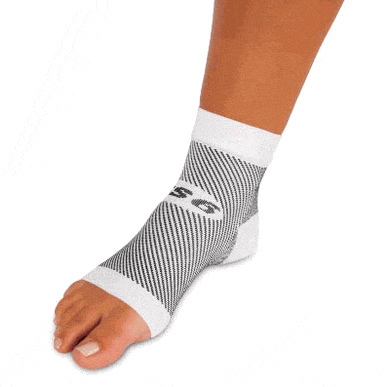Darco Plantar Fasciitis Sleeve Kansas Foot Center
Plantar Fasciitis: Symptoms, Treatment and Prevention

In this final article in both part series on Plantar Fasciitis, Brad Walker talks about the normal symptoms of the painful sports accident as well as the most effective treatments once diagnosed. Brad also describes some very important precautionary measures that are crucial to avoid Plantar Fasciitis. A ft . injury such as plantar fasciitis generally occurs in a single foot. Bilateral plantar fasciitis is strange and tends to be the result of a systemic arthritic condition that is very rare among athletes. Males suffer from a somewhat greater occurrence of plantar fasciitis than females, perhaps because of this of better weight coupled with greater rate and floor impact, as well as less overall flexibility in the foot.Typically, the victim of plantar fasciitis experiences pain upon rising after sleep, specially the first step out of bed. Such pain is firmly localized at the bony landmark on the anterior medial tubercle of the calcaneus. In some instances, pain may prevent the sportsman from walking in a standard heel-toe gait, triggering an unusual walk as means of compensation. Less common regions of pain are the forefoot, Achilles tendon, or subtalar joint.After a brief period of walking with this kind of feet injury, the pain usually subsides, but returns again either with vigorous activity or prolonged standing or walking. Within the field, an changed gait or unusual stride routine, along with pain during jogging or jumping activities are tell-tale signs or symptoms of plantar fasciitis and really should be given prompt attention. Further signs of the personal injury include poor dorsiflexion (lifting the forefoot off the bottom) scheduled to a shortened gastroc complex, (muscles of the calf). Crouching in a full squat position with the sole of the ft . flat on the ground can be utilized as a test, as pain will preclude it for the athlete suffering from plantar fasciitis, creating an elevation of the heel due to tension in the gastroc complex.TreatmentTreatment of plantar fasciitis may also be a drawn out and aggravating process. An application of rehabilitation should be performed by making use of someone licensed and proficient in the affliction. Typically, plantar fasciitis will demand at least six weeks or more to six months of conservative good care to be completely remedied. Should such work not provide comfort to the athlete, more competitive procedures including surgery may be looked at.The initial goals of physical remedy ought to be to increase the passive flexion of the ft . and improve versatility in the foot and ankle, eventually leading to a full return to normal function. Continuous inactivity in vigorous sports is often the price to be payed for thorough recovery. Half measures can lead to a long-term condition, in some instances severely restricting athletic ability.As a large timeframe is spent in bed during sleeping hours, it's important to ensure that the mattress sheets at the foot of the foundation do not constrict the foot, resulting in plantar flexion in which the foot is bent straight out with the toes pointing. This constricts and in that way shortens the gastroc complex, worsening the problem. A home heating pad located under the muscles of the calf for a few momemts prior to growing may help loosen tension, increase circulation in the low leg and decrease pain. Also while asleep, a night splint may be used in order to carry the rearfoot in a natural position. This will aid in the healing of the plantar fascia and ensure that the feet won't become flexed at night time.Attention to footwear is crucial in avoiding ft . injuries. Every work should be made to wear comfortable shoes with proper arch support, fostering proper foot posture. Should arch helps prove inadequate, an orthotic boot should be considered. Fortunately, most circumstances of plantar fasciitis act in response well to non-operative treatment.Recovery times however differ enormously in one athlete to another, depending on get older, overall health and health as well as severeness of injury. A broad period between 6 weeks and 6 months is usually sufficient for proper healing. Additionally, the function of treatment must be flexible depending on the details of a specific athlete?s injury. Methods that verify successful in one patient, might not improve the personal injury in another.Early on treatment of foot injuries typically includes the use of anti-inflammatory medication, icing, stretching activities, and heel inserts and splints. Cortisone injections may be essential to achieve satisfactory therapeutic and retard inflammation. In later levels of the treatment process, typically following the first week, glaciers should be discontinued and substituted with heating and massage.It is critical that any activity recognized to produce soreness or stress to the plantar fascia be immediately discontinued, including any activity involving repeated impact of the heel on a hard surface, particularly, running. Should pain associated with the personal injury persist, additional diagnostic studies should be carried out to eliminate other, more unique causes of heel pain including stress fractures, nerve compression accidental injuries, or collagen disorders of the skin.
Darco Plantar Fasciitis Sleeve Kansas Foot Center's Picture
Related Images with Darco Plantar Fasciitis Sleeve Kansas Foot Center
Plantar Fasciitis: Symptoms, Treatment, Causes, and Prevention

Treatment options for plantar fasciitis Dr. David Geier Sports

Plantar Fasciitis Stretches

Cure Plantar Fasciitis with 100% Guaranteed amp; Safe Method



0 komentar: